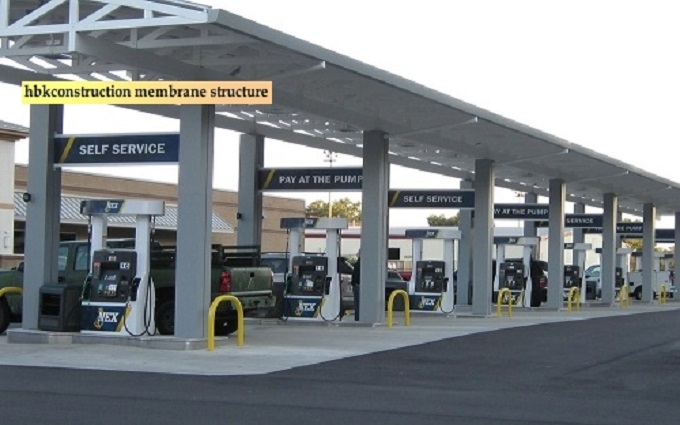HBK Construction Tension Membrane Structure Design for Gas Station Canopies
As the social economy continues to develop, gas stations, as important fuel supply points for vehicles, are widely distributed in urban and rural areas. Consequently, the demand for the architectural structure of gas stations is increasing. This article explores the importance of tension membrane structure design and custom canopy construction for gas stations, detailing the design principles, material selection, and construction process, while providing analysis based on real-life cases to offer guidance for gas station canopy design.

Increasing Vehicle Ownership and Gas Station Demand
With the continuous increase in vehicle ownership, the number of gas stations is also rising. The safety, aesthetics, and functionality of gas station architecture are receiving more attention. In architectural design, the tension membrane structure, as a new form of architecture, is favored for its lightweight, light-transmitting, and self-cleaning properties, becoming a highlight in modern architecture. Meanwhile, the canopy, as an indispensable part of gas station architecture, plays a significant role in ensuring smooth operation.
Importance of HBK Construction's Tension Membrane Structure Design for Gas Stations
1. Enhancing Gas Station Image: The unique shape and vibrant colors of tension membrane structures can add a modern and artistic touch to gas stations, enhancing their image and attracting more customers.
2. Natural Lighting: Tension membrane structures have excellent light-transmitting properties, allowing natural light to enter the gas station during the day, reducing the need for artificial lighting and saving energy.
3. Lightweight Design: Compared to traditional concrete buildings, tension membrane structures are lighter, reducing the amount of building materials used and lowering construction costs.
4. Flexibility and Versatility: Tension membrane structures can be flexibly designed according to the actual conditions of the gas station site, meeting different shapes and sizes, and providing more layout possibilities for gas stations.
Principles and Technical Points of HBK Construction's Tension Membrane Structure Design
- Structural Principles: Tension membrane structures use high-strength thin-film materials stretched into predetermined shapes through tensile force, forming a stable spatial structure. Steel cables or steel frames are typically used as supporting structures, connecting the membrane surface to the support structure through tensile force.
- Material Selection: Common materials include PVC (polyvinyl chloride), PTFE , or PE (polyethylene), which have excellent weather resistance, aging resistance, and light-transmitting properties. The supporting structures usually use galvanized steel pipes or Steel structures for adequate strength and stability.
- Design Considerations: When designing tension membrane structures, the distribution of tensile forces on the membrane surface, the stability of the supporting structure, and the overall wind load capacity must be considered to ensure the safety and reliability of the structure.
Importance and Construction Process of Custom Canopy Design by HBK Construction
- Importance of Canopy Design: As a crucial facility for protecting fueling equipment and vehicles, the design of gas station canopies must consider factors such as drainage systems and wind and rain protection to ensure the normal operation of the equipment.
Construction Process:
1. Plan Design: Design an appropriate canopy plan based on the actual conditions and functional requirements of the gas station site, including structural form, dimensions, and material selection.
2. Material Procurement: Determine the required materials and equipment according to the design plan, including steel structures, membrane materials, and drainage systems, and proceed with procurement and preparation.
3. Construction Preparation: Clear the construction site, set up temporary support structures, determine the construction plan and safety measures, and prepare for construction.
4. Main Construction: Install the supporting structure and membrane according to the design plan, ensuring structural stability and tightness, while also installing the drainage system and other supporting facilities.
5. Inspection and Testing: After completing the main construction, conduct inspection and testing to ensure the facility's normal operation and safe use.
Case Study: Tension Membrane Structure Design and Custom Canopy for a Gas Station
Taking a specific gas station as an example, tension membrane structure design and custom canopy construction were implemented. The design process considered site conditions, environmental requirements, and functional needs, using high-strength PVC membrane and galvanized steel pipe support structures. Through reasonable tensile force distribution and drainage design, the canopy structure achieved stability and waterproofing. After inspection and testing, the canopy design and construction met expectations, receiving unanimous praise from the client.
HBK Construction's tension membrane structure design and custom canopy construction significantly enhance gas station image, achieve natural lighting, and offer lightweight design advantages. In future practice, it is essential to further research design principles and construction techniques to continuously improve the quality and standards of gas station architecture, providing superior services and support for canopy design.
RELATED NEWS
- HBK Construction Nigeria Plant Roof Truss Purlin Installation in Full Swing 2024-05-24
- Construction process of steel structure factory building in Nigeria 2024-05-14
- Steel structure design effectively meets the requirements of work scenarios 2024-05-11
- Affordable Metal Workshop Building Kits 2024-04-26
- Portal Frames 2024-04-15
Categories
Latest News
Contact Us
Contact: Mr.Lu
Phone: +86-51668601029
E-mail: hbktech@163.com
Whatsapp:86+15152106218
Add: 1412, Building 2, Vanke Huaihai Xintiandi, Block 3, Quanshan District, Xuzhou City, Jiangsu Province
